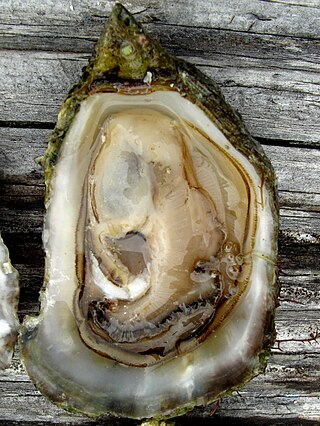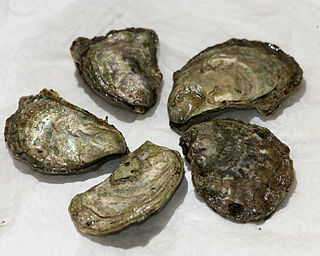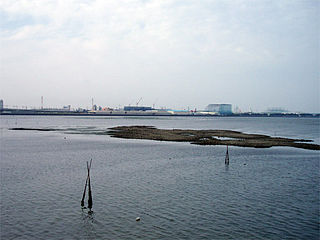Thousands of years prior to European settlement of the Pacific Northwest of the United States the native oyster species Ostrea lurida had been established as a valuable dietary resource for indigenous people living on the coastal waters. European settlers who began to colonize the Pacific Northwest developed an acquired taste for shellfish, especially oysters, a delicacy that were considered to be a symbol of wealth. [1] In the early history of the Pacific Northwest, people satisfied their hunger for shellfish by harvesting naturally occurring oyster beds. It was initially believed that the populations of indigenous oysters were sufficient to supply both tribal and commercial harvest. [2] A marketable industry was created on the export of oysters and soon exploitation of harvesting had depleted the natural oyster beds in California and Oregon. As a result Washington state became the main supplier to areas along the coast which had failed to establish any conservation practices. [3] Noticing the economic value and decline of natural availability, farmers began efforts to cultivate oysters to try to satisfy demand. Over the years the oyster industry of the Pacific Northwest has gone from extremely lucrative to completely nonexistent, but still the industry has been able to adapt and survive.
For the centuries prior to the arrival of European settlement, the native tribes inhabiting the Pacific coast consumed animals from the sea. For example the native people known as the Siwash or "Fish Eaters" included oysters as a main staple in their diet. [4] Evidence of this claim has been proven by the discovery of large piles of discarded shells known as "middens" with specimens dating back 3000–4000 years. The native peoples use of the oyster was a respectful practice and their appreciation for the oyster can be found in their mythology. One legend states that humankind colonized the planet after being able to free themselves from the inside of a sealed oyster. [5] As more white immigrants began to establish settlements along the coast the native people realized the value of oyster and began to harvest them to trade with their new neighbors. In cities such as Tacoma and Seattle it was not uncommon to see natives selling baskets of harvested oysters to the white settlers. [4] Although evidence shows native people engaged in harvesting of oysters, the amount extracted was not great enough to deplete the naturally occurring oyster beds.[ citation needed ]
Early European settlers who arrived in Washington were fueled by Manifest Destiny and held the belief that all natural resources were a gift from God. This idea allowed exploitation in the harvest of natural resources such as oysters, lumber, and salmon. The proof of this mismanagement is shown in the lack of conservation efforts taken by oyster harvesters in the early days of the industry boom. [5] After the native oyster beds of Northern California and Oregon had been depleted, sailing ships began to travel to Willapa Bay which contained vast acreages of native oysters that had been allowed to grow for many years. Between the years 1851-1915 it is estimated that European settlers had removed more than 5 billion individual oysters from Willapa Bay without any consideration of involving cultivation techniques to seed the harvested areas for future oyster populations. [1]
Eventually Washington's native oyster beds were also depleted, but some harvesters recognized the problem and began to take measures to establish regulations on the industry. In an effort to halt the collapse the Washington state legislature passed the Callow Act in 1890 not even a year after Washington had established statehood. The act allowed oyster farmers to purchase tidelands from the government as long as they contained no natural beds. [5] Once the native oyster beds had been exhausted farmers began to import and plant the seeds of Pacific Oyster Crassostrea gigas from Japan. This species proved easier to manage than the native Olympia Oyster and until the present day has been the industries primary focus in oyster growing. [3] Exploitation of harvest is not the only factor attributed to the decline of native oyster populations, pollution has also been attributed to the industry decline. One of the most notable examples occurred in Shelton on the tides of Oakland Bay where pollution from a sulfite lumber mill killed off entire populations of planted oysters. Although there has been debate over whether the lumber mill is to blame, it has been shown that the oyster's population numbers declined during the mills time of operation and increased after it had been closed. [4]
Currently Washington's oyster industries annually harvest more than 7 million pounds of oyster meat at a value estimated around 70 million dollars. [2] Natural oyster beds will never be able to support the numbers needed to meet market demands, but the oyster industry has continued to endure. Learning from past mistakes has led present day farming companies to employ more conservation practices to ensure water quality and healthy specimens.[ citation needed ]

Oyster is the common name for a number of different families of salt-water bivalve molluscs that live in marine or brackish habitats. In some species, the valves are highly calcified, and many are somewhat irregular in shape. Many, but not all oysters are in the superfamily Ostreoidea.

The Pacific geoduck is a species of very large saltwater clam in the family Hiatellidae. The common name is derived from the Lushootseed (Nisqually) word gʷídəq.

Willapa Bay is a bay located on the southwest Pacific coast of Washington state in the United States. The Long Beach Peninsula separates Willapa Bay from the greater expanse of the Pacific Ocean. With over 120 square miles (310 km2) of surface area Willapa Bay is the second-largest riverine estuary on the Pacific coast of the continental United States. Early settlers called the bay Shoalwater Bay and this name is found on old maps and charts of the region.

The eastern oyster —also called the Atlantic oyster, American oyster, or East Coast oyster—is a species of true oyster native to eastern North and South America. Other names in local or culinary use include the Wellfleet oyster, Virginia oyster, Malpeque oyster, Blue Pointoyster, Chesapeake Bay oyster, and Apalachicola oyster. C. virginica ranges from northern New Brunswick south through parts of the West Indies to Venezuela. It is farmed in all of the Maritime provinces of Canada and all Eastern Seaboard and Gulf states of the United States, as well as Puget Sound, Washington, where it is known as the Totten Inlet Virginica. It was introduced to the Hawaiian Islands in the nineteenth century and is common in Pearl Harbor.

Puget Sound is a deep inlet of the Pacific Ocean in Washington, extending south from the Strait of Juan de Fuca through Admiralty Inlet. It was explored and named by Captain George Vancouver for his aide, Peter Puget, in 1792.

The Pacific oyster, Japanese oyster, or Miyagi oyster, is an oyster native to the Pacific coast of Asia. It has become an introduced species in North America, Australia, Europe, and New Zealand.

Oyster farming is an aquaculture practice in which oysters are bred and raised mainly for their pearls, shells and inner organ tissue, which is eaten. Oyster farming was practiced by the ancient Romans as early as the 1st century BC on the Italian peninsula and later in Britain for export to Rome. The French oyster industry has relied on aquacultured oysters since the late 18th century.

Ostrea is a genus of edible oysters, marine bivalve mollusks in the family Ostreidae, the oysters.

The southern mud oyster, Australian flat oyster, native flat oyster, native mud oyster, or angasi oyster, is endemic to southern Australia, ranging from Western Australia to southeast New South Wales and around Tasmania. Ostrea angasi superficially resembles Ostrea edulis and both species may be referred to with the name "flat oyster". However, the two species do not occur naturally in the same geographic distribution.

Yaquina Bay is a coastal estuarine community found in Newport, Oregon. Yaquina Bay is a semi-enclosed body of water, approximately 8 km² (3.2 mi²) in area, with free connection to the Pacific Ocean, but also diluted with freshwater from the Yaquina River land drainage. The Bay is traversed by the Yaquina Bay Bridge.

Ostrea edulis, commonly known as the European flat oyster, is a species of oyster native to Europe. In Britain and Ireland, regional names include Colchester native oyster, mud oyster, or edible oyster. In France, Ostrea edulis are known as huîtres plates except for those that come from the Belon River estuary in Brittany, France, which are known as Belons.

Crepidula fornicata is a species of medium-sized sea snail, a marine gastropod mollusc in the family Calyptraeidae, the slipper snails and cup and saucer snails. It has many common names, including common slipper shell, common Atlantic slippersnail, boat shell, quarterdeck shell, fornicating slipper snail, Atlantic slipper limpet and it is in Britain as the "common slipper limpet".

Netarts Bay is an estuarine bay on the northern Oregon Coast of the U.S. state of Oregon, located about 5 miles (8.0 km) southwest of Tillamook. The unincorporated community of Netarts is located on the north end of the bay and Netarts Bay Shellfish Preserve, managed by Oregon Department of Fish and Wildlife, is located on the south side of the bay. The sand spit on the west side of Netarts bay is part of Cape Lookout State Park.

Ostrea conchaphila is a species of oyster, a marine bivalve mollusk which lives on the Pacific coast of Mexico south of Baja California. Until recently there was some confusion as to whether this more southern oyster species might in fact be the same species as Ostrea lurida, the well-known but more northerly "Olympia oyster", which it resembles in shell size and color. Because of this confusion, the name O. conchaphila was sometimes applied to various populations of what is now known to be O. lurida.

Ostrea lurida, common name the Olympia oyster, after Olympia, Washington in the Puget Sound area, is a species of edible oyster, a marine bivalve mollusk in the family Ostreidae. This species occurs on the northern Pacific coast of North America. Over the years the role of this edible species of oyster has been partly displaced by the cultivation of non-native edible oyster species.

Oyster reef restoration refers to the reparation and reconstruction of degraded oyster reefs. Environmental changes, modern fishing practices, over harvesting, water pollution, and other factors, have resulted in damage, disease, and ultimately, a large decline in global population and prevalence of oyster habitats. Aside from ecological importance, oyster farming is an important industry in many regions around the world. Both natural and artificial materials have been used in efforts to increase population and regenerate reefs.
Bonamia ostreae is a parasitic Rhizaria in the phylum Haplosporidia that can cause lethal infections in shellfish, particularly the European flat oyster, Ostrea edulis. Infection in oysters rarely results in clinical signs of disease and often the only indication of the infection is increased mortality. The Australian flat oyster, Ostrea angasi, has been infected with two similar Bonamia parasites, Bonamia exitiosa and B. roughleyi.
The Suminoe oyster, is a species of true oyster which inhabits intertidal hard grounds and substrate, as well as muddy creeks of warm estuaries throughout the western Pacific. It is large and flat in appearance and almost identical in gross morphology to Crassostrea virginica.

Taylor Shellfish Company is an American seafood company based in Shelton, Washington. It is the country's largest producer of aquaculture (farmed) shellfish and has locations across Western Washington. The Taylor family started raising Olympia oysters in the 1920s. In the current form, the company, privately held, was started in 1969 as Taylor United by brothers Edwin and Justin Taylor, grandsons of James Y. Waldrip, an early Washingtonian who came to Seattle to work rebuilding after the Great Seattle Fire of 1889 before moving south and founding the Olympia Oyster Company in the 1890s. Waldrip's company farmed the Olympia oyster found only in South Puget Sound. Justin Taylor, born 1921, the oldest oyster farmer on Puget Sound in the early 2000s, died in 2011.
The Iwagaki oyster, is an oyster native to Japan. It was first described in 1934.